russian
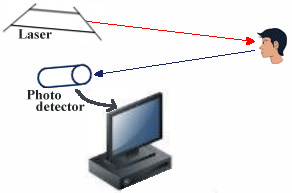 ABSTRACT: Each person has their own characteristic and individual smell. The individuality of the smell is provided by a unique combination of conditions for the formation of the smell. The number of combinations that make up the general smell of a person is very large.
According to the mechanism of formation of odor traces used in forensic odorology, they can be divided into the odors themselves and the sources of the smell.
ABSTRACT: Each person has their own characteristic and individual smell. The individuality of the smell is provided by a unique combination of conditions for the formation of the smell. The number of combinations that make up the general smell of a person is very large.
According to the mechanism of formation of odor traces used in forensic odorology, they can be divided into the odors themselves and the sources of the smell.
The use of odorological information in the fight against crime dates back to the late 19th century. In instrumental odorology (olfactronics), physico-chemical devices are used that can isolate a spectrum of odorous substances. The smell spectrum is called an olfactogram.
The characteristics of sweat smell are so unique to each person that they can be used for biometric identity authentication [2]. The paper [2] describes the prospects for tracking amino acids and secretions in the skin for active multi-factor biometric authentication in the field of cybersecurity.
Researchers from the Polytechnic University of Madrid, in collaboration with the company IIIa Sistemas SL, presented in early 2014 the method of identifying a person by smell: "Identity verification: Body odor as a biometric identifier" [1,7] - "Identity verification: body odor as a biometric identifier". The researchers, in their research, are making progress in developing a new biometric technique that would allow people to be identified by their personal smell. Researchers from UPM [7] concluded that together with Sistemas, they are making progress in developing a new biometric technique that would allow identifying people by their personal smell.
The odors of an individual person are a "layer cake", in which the lower layers are peculiar only to the individual carrier, the higher layers are associated with the current situation and can be caused by cosmetics, workwear, room odors, etc., that is, layers of odors. The decomposition of such a pie into components is solved by using lidars with a tunable frequency of radiation from infrared to violet - the stage of primary separation of the smell layers.
In this paper, a scheme and methods for remote sensing of odors and body parts of people in solving the problem of rapid identification of individuals are proposed. The technical solution is based on the lidar concept for remote registration and analysis of the absorption spectra of odour traces. As radiation sources, laser sources of two or more wavelengths of visible and infrared (ultraviolet) range with a power safe for vision are used [3]. In [3], a lidar with a radiation wavelength of 1.54 microns that is safe for the eyes and eyes was developed. designed to detect fumes and other impurities in the air. It is shown that, depending on the scattering properties of smoke, it is possible to register it at distances up to 10-12 km [3]. The laser power for the problem under consideration can be reduced by 2-3 orders of magnitude, since the distance to the controlled object will be the first tens of meters.
Figure 1. Simplified lidar scheme for atmospheric sensing.[4]
In practice, two schemes of laser sensing of the atmosphere are used. In [6], such schemes of laser control of the composition of atmospheric pollutants by radiation absorption are illustrated. The first scheme is a laser locator, in which the laser beam passes through the path to the photodetector, which is located at the end of the path. Figure 1 shows a variant in which a reflector is installed at the end of the route, while the laser beam passes the route twice-back and forth.
In the second scheme, the photodetector is combined with the emitter and captures the radiation that is reflected from the probed area. Such a scheme for laser monitoring of the state of the atmosphere is called a lidar [6].
Fig. 2. Illustrative scheme of lidar for identification of odors.
Figure 2 shows a lidar circuit for identifying odors. The scheme of the device allows you to combine the source and receiver of radiation in one case. The latter circumstance will ensure the creation of a compact device for operational control and identification of a person.
3. Examples of atmospheric air absorption spectra in the near [0.78-3 micrometers] and middle [3-50 micrometers] infrared IR wavelength range. [5]
In Fig.3. Low-resolution atmospheric absorption spectra are given. The top seven lines represent the absorption spectra of the most important atmospheric species. The lower row of the table simulates the atmospheric absorption spectrum [5]. The atmospheric absorption spectra made by the AVIRIS Classic spectrometer (224 bands) were insufficiently sampled, which corresponded to a spectral resolution of 10 nm, and the sampling interval is also 10 nm. The AVIRIS NG spectrometer provided a resolution of about 5 nm with a number of bands of more than 400 to cover 0.38-2.5 in the micron spectral range of waves.
Spectral analysis of the emission and absorption spectra allows us to determine the composition of the substance at a qualitative level. The absorption spectrum is a dark line against the background of a continuous source spectrum. The quantitative characterization of the smell components is based on the measurement of the brightness of the spectral lines. Knowing the wavelengths emitted (absorbed) by different pairs, you can determine the presence of certain components.
Mathematical processing of the probing results can be based on image recognition methods, and in particular on cluster methods with training, which are called neural networks.
From a statistical point of view, the optimal classification quality is Bayesian classifier [8, etc.]. The optimal decision function, in this case, the characteristic set x that belongs to class Wi is determined by the likelihood ratio:
p(x|Wi)/p(x|Wj) > 1
for all j and i, j=/=i, where p(x|Wk) is the conditional probability for the characteristics x provided that they belong to the class Wk.
If the classifier gives an erroneous decision that the data set x belongs to the class Wi, when in fact x belongs to the class Wj, then the classifier suffers losses, which are called errors of the first and second kind. Bayes' rule allows you to estimate the mathematical expectation of losses and express posterior probabilities in terms of conditional and prior.
Error of the first kind-assignment to class Wi of an object belonging to another class. The mistake is equivalent to a situation where you met an acquaintance and did not recognize him (will be rich). Error of the second kind-assigning an object to class Wi that does not belong to this class. This is equivalent to taking an unknown person for an acquaintance (to be poor to him). The effectiveness of correctly assigning an object to the appropriate class is estimated by the marginal probability Pe in the figure below:
Fig. 4. Probability distribution of errors of the first and second kind.
The desire for a more complete description of recognition objects allows you to reduce errors of the 1st kind. In turn, the expansion of the feature space leads to an increase in errors of the 2nd kind[9]. Fuzzy sets of conditional probability densities do not allow avoiding recognition errors in the principle (Fig.4).
CONCLUSIONS . 1) The success of the classification depends on the quality of the densities of the conditional probability distribution. 2) The risks of losses cannot be reduced below a certain amount.
LITERATURE:
Lidar for remote identification of a person by smell
 ABSTRACT: Each person has their own characteristic and individual smell. The individuality of the smell is provided by a unique combination of conditions for the formation of the smell. The number of combinations that make up the general smell of a person is very large.
According to the mechanism of formation of odor traces used in forensic odorology, they can be divided into the odors themselves and the sources of the smell.
ABSTRACT: Each person has their own characteristic and individual smell. The individuality of the smell is provided by a unique combination of conditions for the formation of the smell. The number of combinations that make up the general smell of a person is very large.
According to the mechanism of formation of odor traces used in forensic odorology, they can be divided into the odors themselves and the sources of the smell.
The use of odorological information in the fight against crime dates back to the late 19th century. In instrumental odorology (olfactronics), physico-chemical devices are used that can isolate a spectrum of odorous substances. The smell spectrum is called an olfactogram.
The characteristics of sweat smell are so unique to each person that they can be used for biometric identity authentication [2]. The paper [2] describes the prospects for tracking amino acids and secretions in the skin for active multi-factor biometric authentication in the field of cybersecurity.
Researchers from the Polytechnic University of Madrid, in collaboration with the company IIIa Sistemas SL, presented in early 2014 the method of identifying a person by smell: "Identity verification: Body odor as a biometric identifier" [1,7] - "Identity verification: body odor as a biometric identifier". The researchers, in their research, are making progress in developing a new biometric technique that would allow people to be identified by their personal smell. Researchers from UPM [7] concluded that together with Sistemas, they are making progress in developing a new biometric technique that would allow identifying people by their personal smell.
The odors of an individual person are a "layer cake", in which the lower layers are peculiar only to the individual carrier, the higher layers are associated with the current situation and can be caused by cosmetics, workwear, room odors, etc., that is, layers of odors. The decomposition of such a pie into components is solved by using lidars with a tunable frequency of radiation from infrared to violet - the stage of primary separation of the smell layers.
In this paper, a scheme and methods for remote sensing of odors and body parts of people in solving the problem of rapid identification of individuals are proposed. The technical solution is based on the lidar concept for remote registration and analysis of the absorption spectra of odour traces. As radiation sources, laser sources of two or more wavelengths of visible and infrared (ultraviolet) range with a power safe for vision are used [3]. In [3], a lidar with a radiation wavelength of 1.54 microns that is safe for the eyes and eyes was developed. designed to detect fumes and other impurities in the air. It is shown that, depending on the scattering properties of smoke, it is possible to register it at distances up to 10-12 km [3]. The laser power for the problem under consideration can be reduced by 2-3 orders of magnitude, since the distance to the controlled object will be the first tens of meters.
Lidar protypes for individual identification:
Structurally, the lidar protopype for identifying a person by smell can serve as the well-known lidar schemes used to obtain absorption spectra in the analysis of atmospheric air. A simplified lidar scheme for atmospheric sounding is presented in Fig. 1 [4].
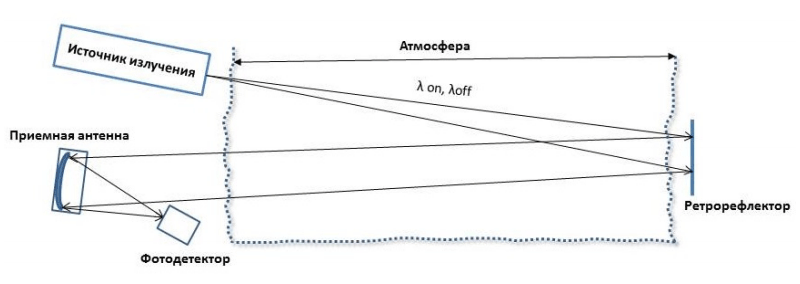
|
In practice, two schemes of laser sensing of the atmosphere are used. In [6], such schemes of laser control of the composition of atmospheric pollutants by radiation absorption are illustrated. The first scheme is a laser locator, in which the laser beam passes through the path to the photodetector, which is located at the end of the path. Figure 1 shows a variant in which a reflector is installed at the end of the route, while the laser beam passes the route twice-back and forth.
In the second scheme, the photodetector is combined with the emitter and captures the radiation that is reflected from the probed area. Such a scheme for laser monitoring of the state of the atmosphere is called a lidar [6].
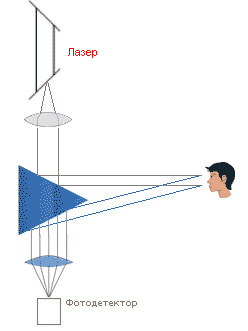
|
Fig. 2. Illustrative scheme of lidar for identification of odors.
Figure 2 shows a lidar circuit for identifying odors. The scheme of the device allows you to combine the source and receiver of radiation in one case. The latter circumstance will ensure the creation of a compact device for operational control and identification of a person.
Absorption spectra:
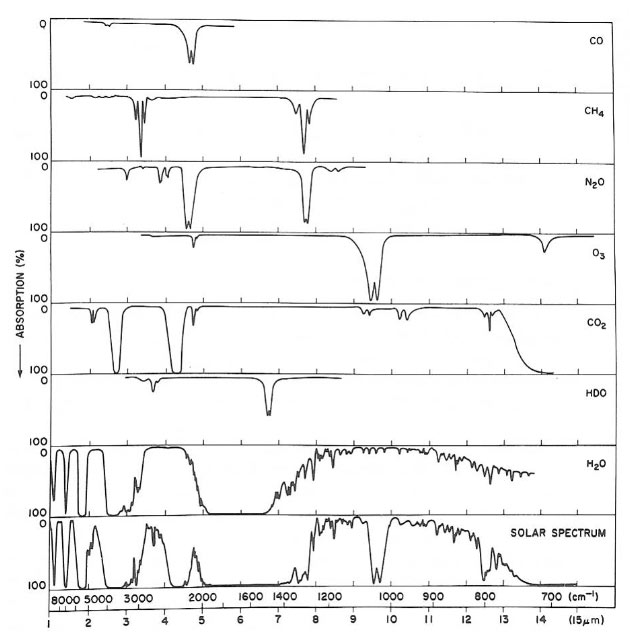
|
In Fig.3. Low-resolution atmospheric absorption spectra are given. The top seven lines represent the absorption spectra of the most important atmospheric species. The lower row of the table simulates the atmospheric absorption spectrum [5]. The atmospheric absorption spectra made by the AVIRIS Classic spectrometer (224 bands) were insufficiently sampled, which corresponded to a spectral resolution of 10 nm, and the sampling interval is also 10 nm. The AVIRIS NG spectrometer provided a resolution of about 5 nm with a number of bands of more than 400 to cover 0.38-2.5 in the micron spectral range of waves.
Spectral analysis of the emission and absorption spectra allows us to determine the composition of the substance at a qualitative level. The absorption spectrum is a dark line against the background of a continuous source spectrum. The quantitative characterization of the smell components is based on the measurement of the brightness of the spectral lines. Knowing the wavelengths emitted (absorbed) by different pairs, you can determine the presence of certain components.
Mathematical processing of the probing results can be based on image recognition methods, and in particular on cluster methods with training, which are called neural networks.
Mathematical processing:
The automatic recognition scheme contains three main blocks: the radiation sensor, the classifier, and the classifier training block. The sensor converts the physical characteristics of the recognition object into a set of formal features x. The main success in the implementation of such a device is based on the independence of the characteristics measured by the sensor. The algorithm for constructing the classifier provides the assignment of feature values to one of a finite number of classes. Training block ... (with a teacher).From a statistical point of view, the optimal classification quality is Bayesian classifier [8, etc.]. The optimal decision function, in this case, the characteristic set x that belongs to class Wi is determined by the likelihood ratio:
p(x|Wi)/p(x|Wj) > 1
for all j and i, j=/=i, where p(x|Wk) is the conditional probability for the characteristics x provided that they belong to the class Wk.
If the classifier gives an erroneous decision that the data set x belongs to the class Wi, when in fact x belongs to the class Wj, then the classifier suffers losses, which are called errors of the first and second kind. Bayes' rule allows you to estimate the mathematical expectation of losses and express posterior probabilities in terms of conditional and prior.
Error of the first kind-assignment to class Wi of an object belonging to another class. The mistake is equivalent to a situation where you met an acquaintance and did not recognize him (will be rich). Error of the second kind-assigning an object to class Wi that does not belong to this class. This is equivalent to taking an unknown person for an acquaintance (to be poor to him). The effectiveness of correctly assigning an object to the appropriate class is estimated by the marginal probability Pe in the figure below:
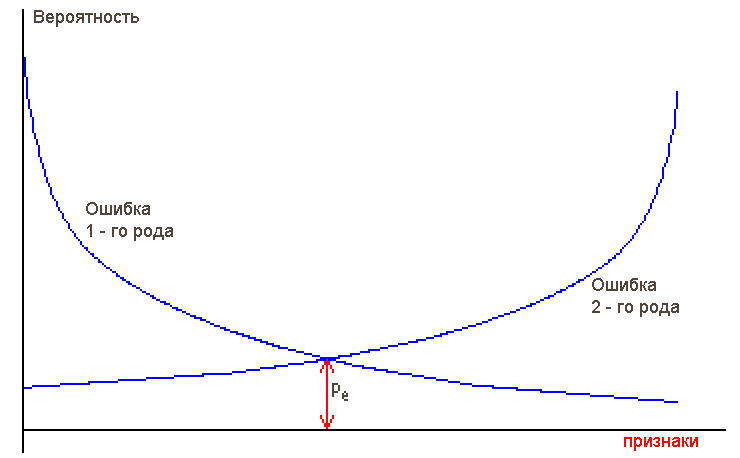
|
The desire for a more complete description of recognition objects allows you to reduce errors of the 1st kind. In turn, the expansion of the feature space leads to an increase in errors of the 2nd kind[9]. Fuzzy sets of conditional probability densities do not allow avoiding recognition errors in the principle (Fig.4).
CONCLUSIONS . 1) The success of the classification depends on the quality of the densities of the conditional probability distribution. 2) The risks of losses cannot be reduced below a certain amount.
LITERATURE:
[1]. Identity verification: Body odor as a biometric identifier. February 4, 2014. Universidad Politecnica de Madrid https://www.sciencedaily.com/releases/2014/02/140204073823.htm
[2]. Promisesand Challengesin ContinuousTrackingUtilizingAminoAcidsin SkinSecretionsfor ActiveMulti-FactorBiometricAuthentication for Cybersecurity. ChemPhysChem2017,18,1714 -1720. https://onlinelibrary.wiley.com/doi/epdf/10.1002/cphc.201700044
[3]. LIDAR WITH VISION-SAFE RADIATION. // NAUCHNOE PRIBOROSTROENIE, 2002, vol. 12, no. 4, p. 81-86. https://cyberleninka.ru/article/n/lidar-s-bezopasnym-dlya-zreniya-izlucheniem
[4]. Development and creation of a model of a laser differential absorption gas analyzer for trace measurements in real urban conditions based on a laser. // Thesis, 2015. https://kpfu.ru/portal/docs/F1806603334/Zuev.pdf
[5]. Introduction to Atmospheric Spectroscopy and Spectral Technique. June 2016. Remote Sensing Division, Naval Research Laboratory, Washington, DC USA. https://hyspiri.jpl.nasa.gov/downloads/2016_Symposium/day1/III-4_Gao_GSFC_HyspIRI_Imaging_spectrometry_6_2016.pdf]
[6]. LASER CONTROL OF ATMOSPHERIC AND OCEAN POLLUTION. https://texts.news/populyarnaya-fizika_1438/ lazernyiy-kontrol-zagryazneniy-atmosferyi-50069.html
[7]. Universidad Polit?cnica de Madrid (UPM). http://www.upm.es/internacional/Students/StudiesDegrees/ University+Masters/Admission/
[8]. J. Tu, R. Gonzalez - Principles of pattern recognition.
[9]. M. Smirnov, I. Sivyakov - Recognition of portrait images in the problem of automatic classification. https://cache-spb04.cdn.yandex.net/download.yandex.ru/
company/grant/2005/03_Smirnov_102804.pdf
[2]. Promisesand Challengesin ContinuousTrackingUtilizingAminoAcidsin SkinSecretionsfor ActiveMulti-FactorBiometricAuthentication for Cybersecurity. ChemPhysChem2017,18,1714 -1720. https://onlinelibrary.wiley.com/doi/epdf/10.1002/cphc.201700044
[3]. LIDAR WITH VISION-SAFE RADIATION. // NAUCHNOE PRIBOROSTROENIE, 2002, vol. 12, no. 4, p. 81-86. https://cyberleninka.ru/article/n/lidar-s-bezopasnym-dlya-zreniya-izlucheniem
[4]. Development and creation of a model of a laser differential absorption gas analyzer for trace measurements in real urban conditions based on a laser. // Thesis, 2015. https://kpfu.ru/portal/docs/F1806603334/Zuev.pdf
[5]. Introduction to Atmospheric Spectroscopy and Spectral Technique. June 2016. Remote Sensing Division, Naval Research Laboratory, Washington, DC USA. https://hyspiri.jpl.nasa.gov/downloads/2016_Symposium/day1/III-4_Gao_GSFC_HyspIRI_Imaging_spectrometry_6_2016.pdf]
[6]. LASER CONTROL OF ATMOSPHERIC AND OCEAN POLLUTION. https://texts.news/populyarnaya-fizika_1438/ lazernyiy-kontrol-zagryazneniy-atmosferyi-50069.html
[7]. Universidad Polit?cnica de Madrid (UPM). http://www.upm.es/internacional/Students/StudiesDegrees/ University+Masters/Admission/
[8]. J. Tu, R. Gonzalez - Principles of pattern recognition.
[9]. M. Smirnov, I. Sivyakov - Recognition of portrait images in the problem of automatic classification. https://cache-spb04.cdn.yandex.net/download.yandex.ru/
company/grant/2005/03_Smirnov_102804.pdf